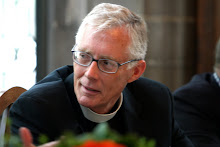We all inhabit what feels like an apocalyptic moment. We are in the midst of cataclysmic changes which affect all of us, and we have no clear idea of how things will come out. The economic crisis which engulfs our nation and the world is one part of that. The seemingly endless presidential election is another. And let’s not even start on the church. We don’t need to read Mark’s Gospel to know that things are changing dramatically all around us. If you want to see disruption, dislocation, and judgment, just look at what’s going on in our culture right here and right now.
In apocalyptic moments, it is a natural human tendency to want to hold on to things that appear to be fixed and solid. In the cultural chaos of the 1970s, the 1928 Prayer Book and the all-male priesthood became focal points of stability for many who found the liturgical questioning of Christendom and the expanding of clerical gender roles troubling. In our own day, the quest of gays, lesbians, and same sex couples for full inclusion in the church’s ministries and sacraments has driven many to define opposite-sex marriage as a core tenet of Christian doctrine. When the earth begins shaking, it is tempting to cling to something that looks solid, even if it’s only a piece of balsa wood.
Something like this must have been in the mind of Jesus’s companions when they looked upon the Jerusalem Temple. Here is how Mark’s Gospel puts it:
As he came out of the temple, one of his disciples said to him, ‘Look, Teacher, what large stones and what large buildings!’ Then Jesus asked him, ‘Do you see these great buildings? Not one stone will be left here upon another; all will be thrown down.’--Mark 13.1-2
Their reaction, we can imagine, was a variety of shock. “‘Tell us, when will this be, and what will be the sign that all these things are about to be accomplished?’” they ask [Mark 13.4]. If you were a Palestinian Jewish peasant from the north country near Nazareth, where the biggest town you had ever seen was Caesarea Philippi, you too might marvel not only at the size of Jerusalem and its Temple but at the prospect that anything so big, so permanent, so solid might not be strong and secure enough to last forever.
When we put our faith in proximate things rather than in final things, when we confuse the signs of God’s presence with the reality of God’s presence, we tend to become unstuck when the thing we have mistakenly put our trust in turns out to be just another species of balsa wood. For all its solidity and permanence, the Jerusalem Temple proved in A.D. 70 to be as fragile as a Hollywood back lot set.
Fortunately, women and men come into our experience and remind us, through their lives and witness, that there is some One behind all the transient show of life who is trustworthy and who will endure. Such a person was the man, new to our liturgical calendar, whom we remember today, George Kennedy Allen Bell. You could not ask for a more establishment church career than the one Bell had—study at Oxford, Dean of Canterbury Cathedral, Bishop of Chichester, and leading contender to be Archbishop of Canterbury when William Temple died in 1944. Yet his ministry involved some risky commitments and decisions: in the early 1930s Bell was President of the “Life and Work” Conference at the World Council of Churches in Geneva, and over the course of his life he was a leading figure in the Ecumenical Movement. More than that, Bell was also the first and most stalwart international ally of Dietrich Bonhoeffer and the Confessing Church which opposed Hitler and Nazism in Germany in the 1930s and 1940s. And even beyond that, Bell was also a lifelong advocate of peace: late in World War II he spoke out publicly against the indiscriminate area bombing of German cities because it killed hundreds of thousands of innocent noncombatants; and this opposition probably cost him becoming Archbishop of Canterbury. And after the War he vigorously opposed Britain’s development and deployment of nuclear weapons.
When you live in apocalyptic times, it is easy to become confused about what is eternal and what is transitory. For us, looking at someone like George Kennedy Allen Bell from a distance, it would be easy to mistake the trappings of his ministry—Oxford, Canterbury Cathedral, the see of Chichester, an international ecclesiastical reputation—as the thing itself. But Bell knew better than that. He knew that the signs of his ministry were not ends in themselves but were rather tools to be used in the service of God’s ever-expanding horizon of justice, love, reconciliation, and peace. Having a big church career was not his ministry. Using the resources of his title and office in the service of Jesus and his cause was. He knew what was eternal and what was transitory. It is that kind of knowledge which will sustain us in apocalyptic times.
“‘Do you see these great buildings? Not one stone will be left here upon another; all will be thrown down.’” If you’ve put your faith in transitory signs as the ultimate sources of meaning, then Jesus’s words this morning are bad news. But if, like George Kennedy Allen Bell, you’ve understood that the One who made and loves us will continue to be in and with and for us no matter even if the medium through which we’ve come to know that One disintegrates, then you can live a life of blessing and freedom and mercy and peace. May each of us, in our own way, shift our attention from that which passes to that which endures, so that we may accompany Jesus and each other on a journey of faith toward the One in whom our security and safety finally rest. Amen.
Subscribe to:
Post Comments (Atom)


No comments:
Post a Comment